#The Paintings of Terance James Bond
Text


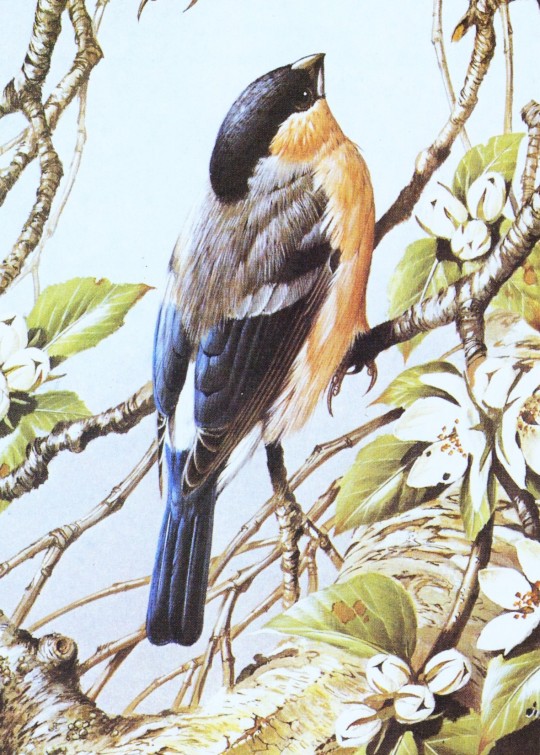


A Bullfinch Feathursday
The colorful Eurasian Bullfinch (Pyrrhula pyrrhula) is a strikingly beautiful bird to encounter. but it is not always the most welcome in orchards because of their preferred foods: berries and the buds of fruit trees. These images are from paintings by the British bird artist Terance James Bond as reproduced in our folio volume Birds, The Paintings of Terance James Bond, published in Cambridge, England, by the Lutterworth Press in 1988. Of the Bullfinch and its depiction, Bond writes:
Bullfinches and fruit trees do not mix, or rather they do, and that is the problem. . . . Bullfinches love buds. The name Bullfinch is probably a corruption of the words bud finch. . . . A pair of these lovely little birds can cause havoc on a fruit tree in a very short time, and several pairs over a period of a couple of weeks can destroy the potential fruit crop of an entire orchard.
[B]y illustrating the species in a setting of pear blossoms, I would seem to be confirming the Bullfinch's regrettable behaviour. . . . The bright pink breast of the cock is so vivid and of such an isolated pigment range, that there is very little that can be utilised as background without a terrible clash of colour. White is the obvious choice and so is pale green, both are tints that harmonise well with pink. So in the end I chose the bird's favourite tree as the basis of composition.
View more posts with paintings by Terance James Bond.
View more Feathursday posts.
#Feathursday#Eurasian Bullfinch#bullfinches#bird paintings#bird painters#Terance James Bond#The Paintings of Terance James Bond#Lutterworth Press#birds#birbs!
79 notes
·
View notes
Photo
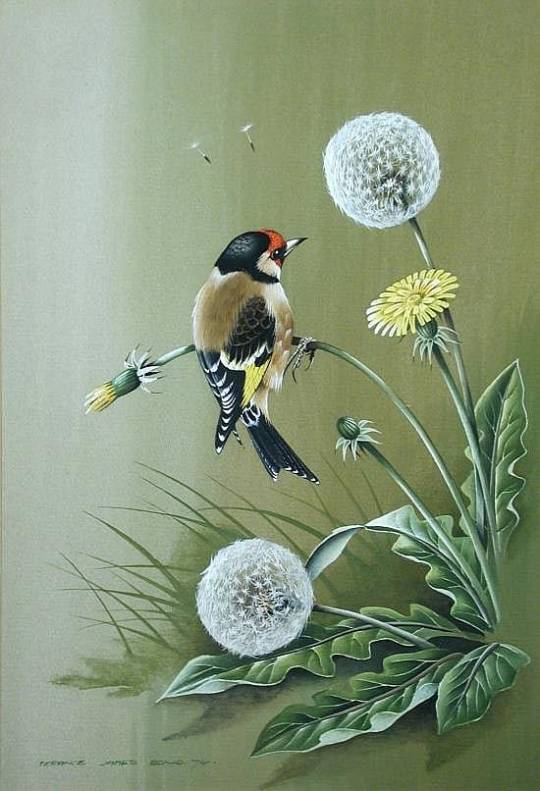
Terance James Bond (British,b.1946)
Study of a Goldfinch, 1974
Watercolour
88 notes
·
View notes
Photo
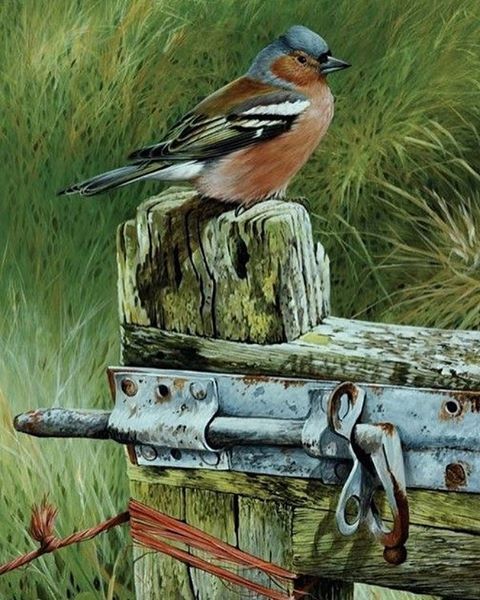
From looking at the #details of this #nice #piece of #art #work by #Terance #James #Bond. The #painting looks so #real😊😉
0 notes
Text
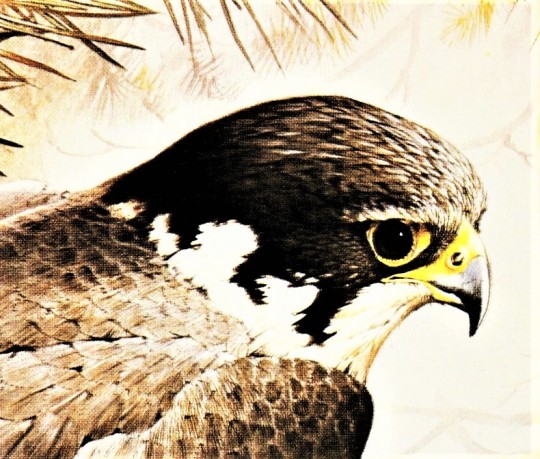



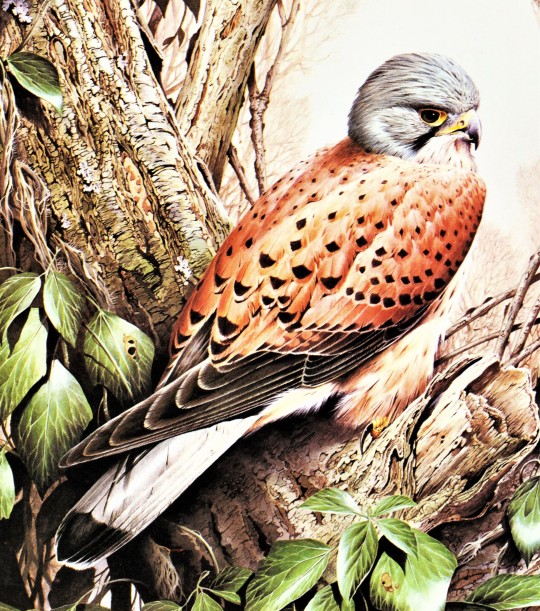

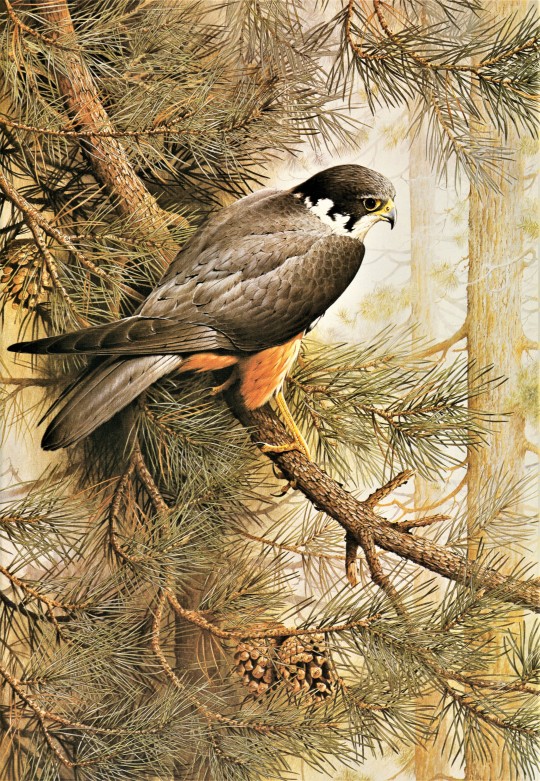
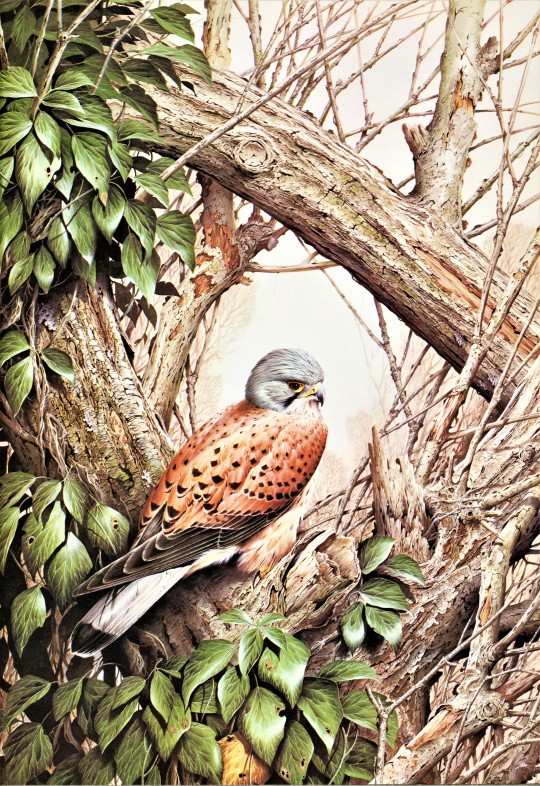

A Falco Feathursday
This Feathursday we showcase three of the smallest falcons in Europe and America: the Eurasian Hobby (Falco subbuteo), Common Kestrel (Falco tinnunculus), and American Kestrel (Falco sparverius). All are in the genus Falco, and all occupy a similar niche within the falcon genus, although the Hobby is more falconesque in its hunting behavior. The American Kestrel, however, may not be a true kestrel, but seems more closely related to other North American falcons.
These paintings are by the British bird artist Terance James Bond and are reproduced in our folio volume Birds, The Paintings of Terance James Bond, published in Cambridge, England, by the Lutterworth Press in 1988. Of his painting of the American Kestrel, Bond writes:
The species . . . can be found in parkland, farmland, and the margins of towns and villages [and cities!]. To hint at this association with modern man I have chosen to illustrate my male bird against a setting of sawn logs. This I feel works very well, the firewood is a perfectly natural element but the presence of civilised man is suggested through the obviously unnatural arrangement of the timber. The bird could be sunning itself in somebody's farmyard or rural garden and has taken advantage of the perching point whilst it sits and waits for the arrival of a potential snack.
View more posts with paintings by Terance James Bond.
View more Feathursday posts.
#Feathursday#Eurasian Hobby#hobby (bird)#Common Kestrel#American Kestrel#kestrels#bird paintings#bird painters#Terance James Bond#The Paintings of Terance James Bond#Lutterworth Press#Falco#falcons#birds#birbs!
83 notes
·
View notes
Text

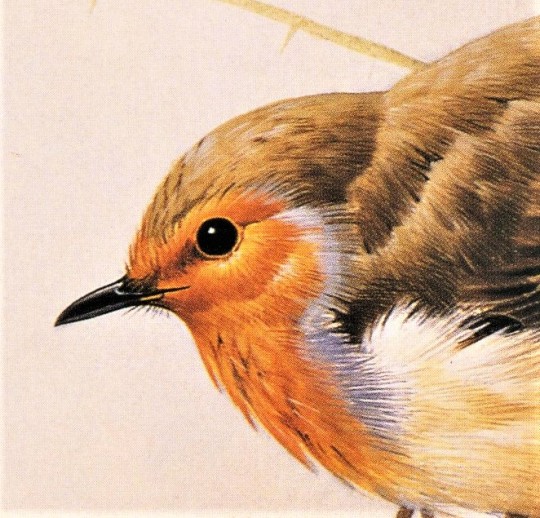
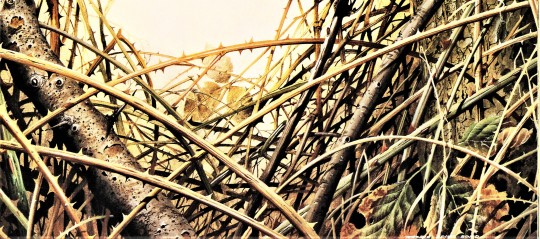
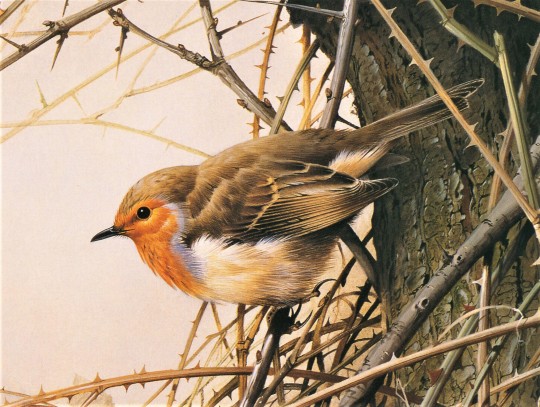

A European Robin Feathursday
The American Robin (Turdus migratorius) and the European Robin (Erithacus rubecula) are among the most common and beloved birds in there respective continents. Unlike the American Robin, however, which is a large thrush, the European Robin is a small bird in the chat subfamily of Old World flycatchers. For us they are in the subfamily of European borbs!
The image shown here is a reproduction of a painting by British bird artist Terance James Bond from our folio volume Birds, The Paintings of Terance James Bond, published in Cambridge, England by the Lutterworth Press in 1988. Bond writes, "The Robin . . . can be found throughout the British Isles . . . . It is, therefore, a bird with which everyone is familiar." He continues:
Ask almost everybody in the United Kingdom which of all our resident birds they would consider to be their favourite and the answer will be the same. A survey carried out in 1961 by the International Council for Bird Protection, after long deliberation and much correspondence in the national press, finally elected the Robin as Britain's national bird.
View more posts with paintings by Terance James Bond.
View more Feathursday posts.
#Feathursday#European Robin#British national bird#Terance James Bond#bird paintings#bird painters#bird artists#Terance James Bond from our folio volume Birds#The Paintings of Terance James Bond#Lutterworth Press#birds#birbs!#borbs
62 notes
·
View notes
Photo
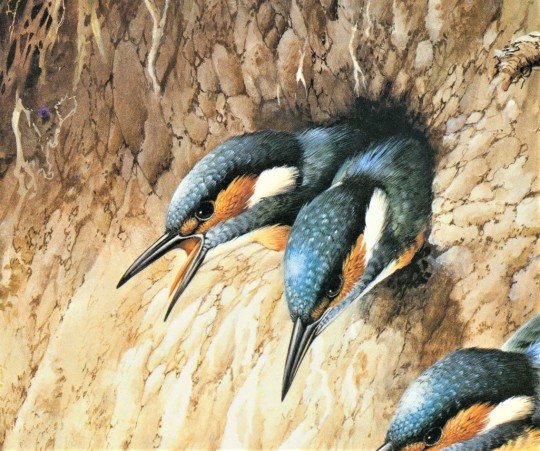

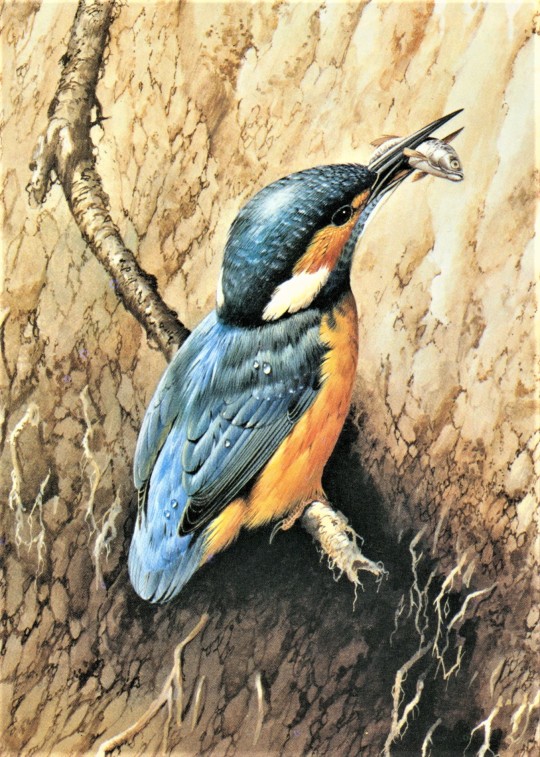
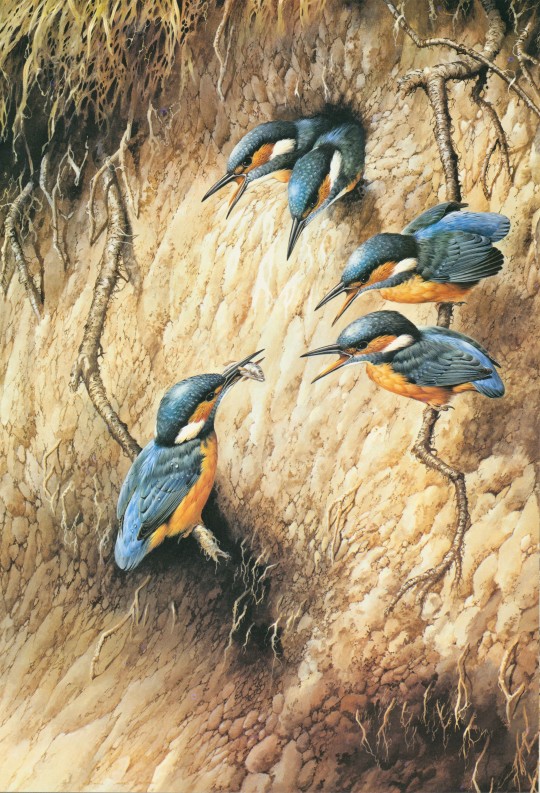
A Kingfisher Family Feathursday
We return to British bird artist Terance James Bond‘s folio volume Birds, The Paintings of Terance James Bond, published in Cambridge, England by the Lutterworth Press in 1988, with this offset reproduction of his painting of a family of Common Kingfishers (Alcedo atthis). The species is found throughout Eurasia and North Africa, and its sparrow-like size makes it considerably smaller than our own North American Belted Kingfisher (Megaceryle alcyon). On painting Kingfishers, Bond writes:
When it comes to painting the bird the artist is presented with a problem. Running down the centre of the Kingfisher's back and tail is a line of feathers taht are impossible to represent in paint. Their vivid blue is incandescent in nature and as the bird moves, or as the light changes, so does the colour, varying from one brilliant hue to the next. . . . This effect . . . is referred to scientifically as the Tyndall effect. All the artist can do is represent one of the range of reflected colours in as near a ‘kingfisher blue’ as the palette allows.
View more posts with paintings by Terance James Bond.
View more Feathursday posts.
#Feathursday#Common Kingfisher#Terance James Bond#Lutterworth Press#Birds The Paintings of Terance James Bond#bird paintings#wildlife art#wildlife artists#birds#birbs!
269 notes
·
View notes
Photo

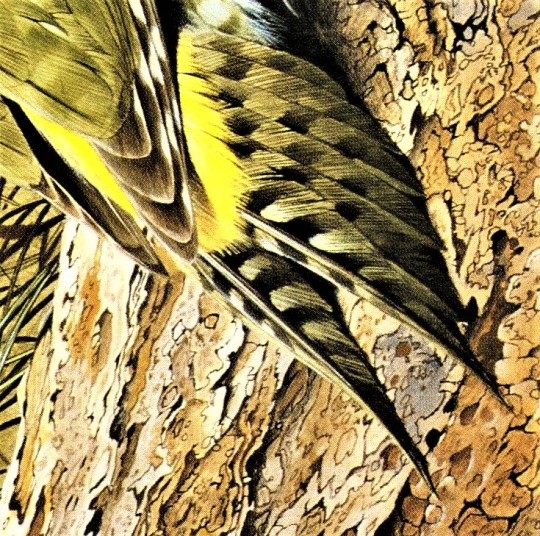

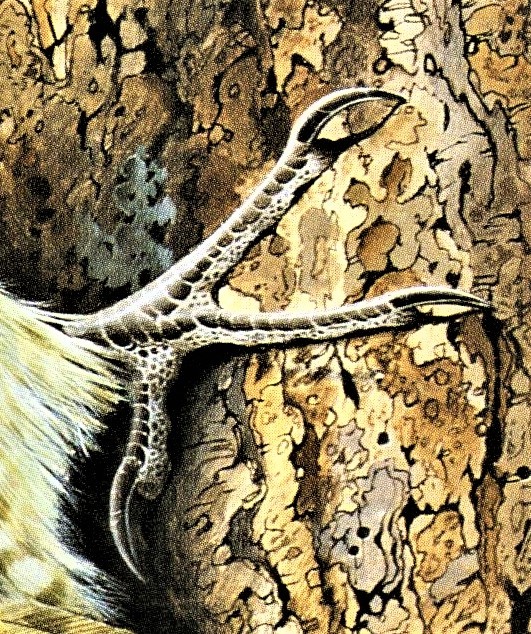

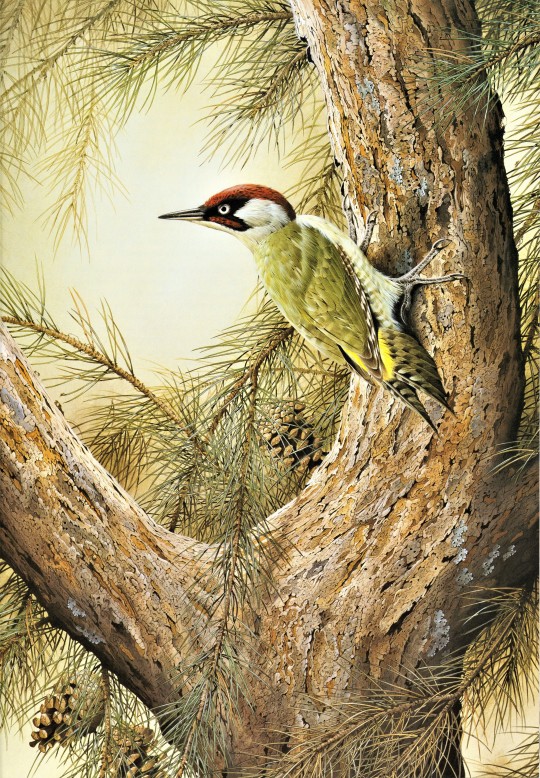
Another Peckin’ Feathursday
This week we present the stately European Green Woodpecker (Picus viridis), reproduced from a painting by British bird artist Terance James Bond in his folio volume Birds, The Paintings of Terance James Bond, published in Cambridge, England by the Lutterworth Press in 1988. Bond writes:
This is the largest of the three woodpeckers that are resident in the British Isles and in my humble opinion the most handsome [no argument there]. From the illustrator’s point of view the woodpeckers are particularly pleasing birds to draw and paint. Why? Well, just look at the shape!
Much like our own Northern Flicker, the Green Woodpecker has a penchant for ground-feeding in the hunt for insects, especially ants. .Bond observes, “Green Woodpeckers are regular visitors to my lawns and I have to admit the sight of these birds hopping across the ground amidst the company of Blackbirds and Song Thrushes is rather odd.” About this painting, Bond writes:
The colours in my illustration have been kept within the range of greens and browns, in order to make a visual feature of the only other colours in the painting, the red and black in the bird’s head. Scots pine was chosen as a background because I thought the shape of the needles echoed the dominant shape of the woodpecker’s head.
View more posts with paintings by Terance James Bond.
View more posts with woodpeckers.
View more Feathursday posts.
#Feathursday#European Green Woodpecker#Green Woodpecker#bird paintings#bird painters#Terance James Bond#Lutterworth Press#Birds The Paintings of Terance James Bond#woodpeckers#birds#birbs!
58 notes
·
View notes
Photo

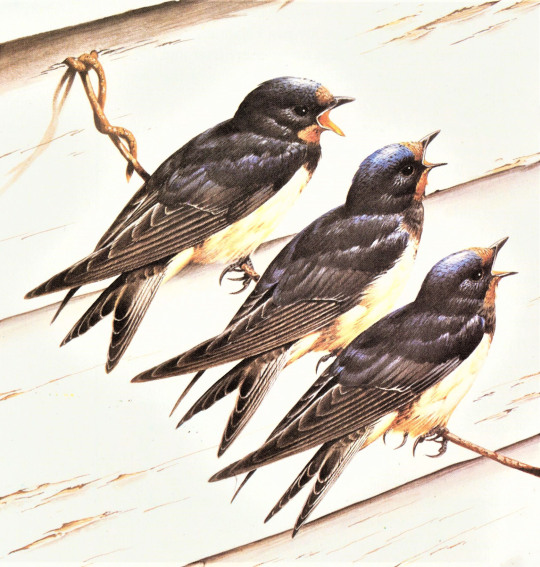
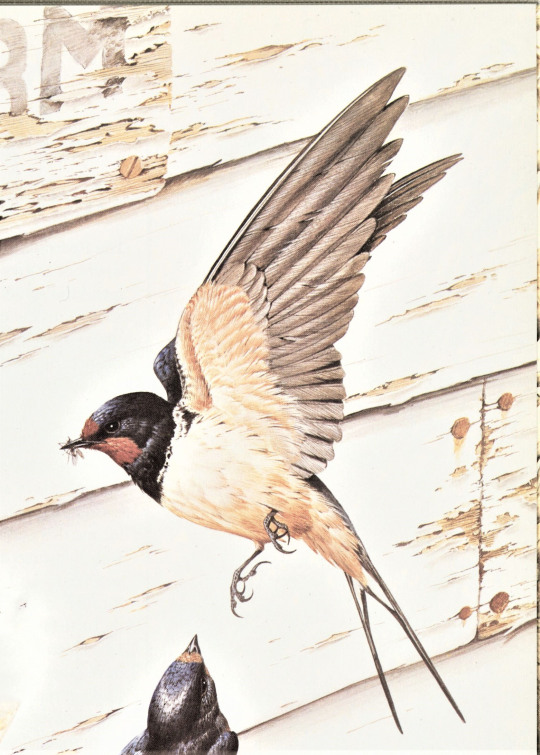
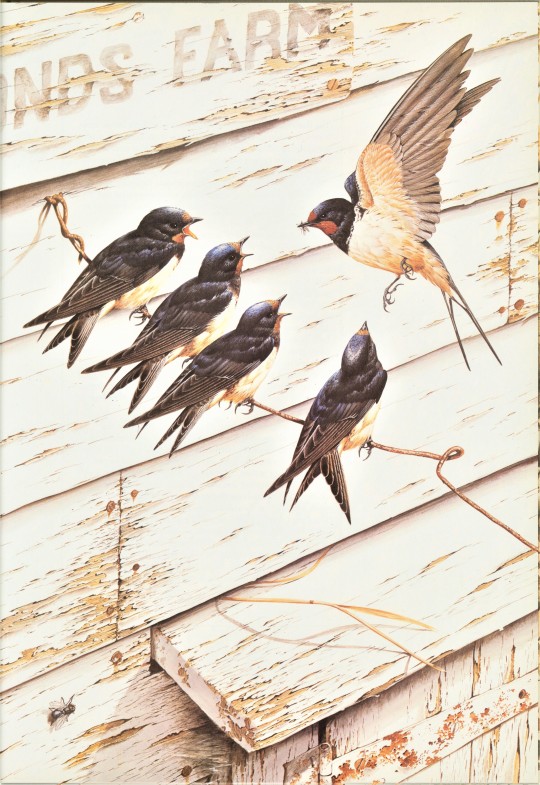

Feathursday Swallows
A sure sign that winter is long gone and summer is upon us is the return of swallows from their far southern winter havens. In Wisconsin we have Northern Rough-winged, Tree, Bank, Cliff, and Barn swallows. In English-speaking Europe, most species of swallow are called martins. For instance, our Bank Swallow is called the Sand Martin in England. The only bird referred to simply as the Swallow is what we call the Barn Swallow.
The family of Barn Swallows shown here (or in England, just Swallows) is a reproduction of a painting by British bird artist Terance James Bond from our folio volume Birds, The Paintings of Terance James Bond, published in Cambridge, England by the Lutterworth Press in 1988. Of the painting, Bond writes:
I have deliberately placed the birds against a fairly light and plain background of an old white-painted timbered building, a device which has helped accentuate the delicate and streamlined tail feathers of the adult bird. There is no obvious difference between the plumage of the male and female Swallow. The simplest way, however, to tell male from female is the length of the tail streamers; the male has the longest, the female the next longest and birds born during the year the shortest.
View more posts with paintings by Terance James Bond.
View more Feathursday posts.
#Feathursday#Barn Swallows#swallows#Terance James Bond#Lutterworth Press#bird paintings#birds#birbs!
25 notes
·
View notes
Photo



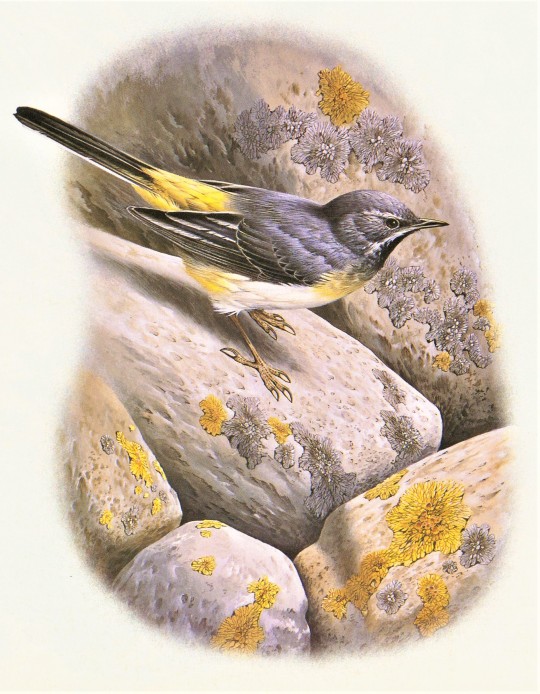
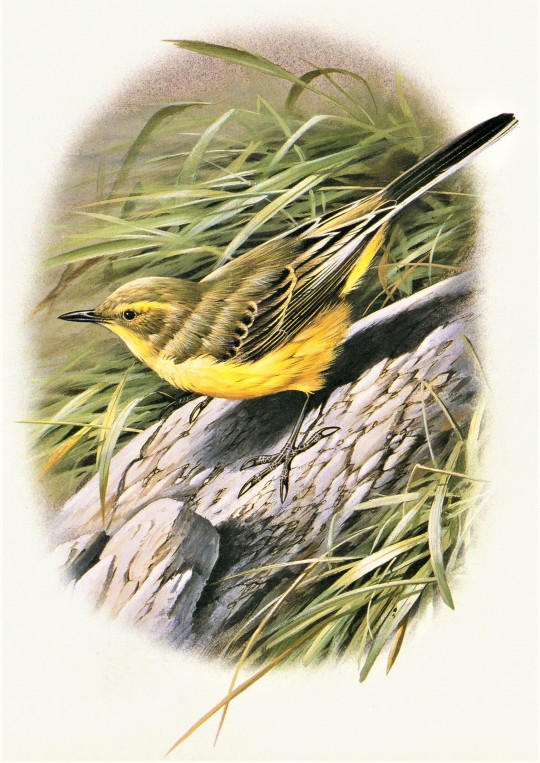



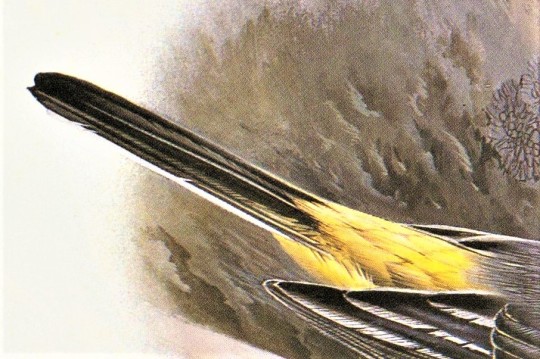

A Wagtail Feathursday
This week we highlight some Wagtails in the genus Motacilla. The only wagtails found in North America are subspecies of the Eurasian Yellow and White Wagtails that have established a foothold in far western Alaska. Therefore we turn to the three species of wagtail most commonly found in Europe:
White Wagtail (Motacilla alba). A black and white bird, a subspecies of which, the Pied Wagtail, most commonly found in Britain, is shown here.
Grey Wagtail (Motacilla cinerea). A grey-headed bird with yellow rump and underparts.
Yellow Wagtail (Motacilla flava). A bird with bright yellow underparts from chin to rear.
All of these birds have long dark tails with white outer bars. Their common name derives from their most conspicuous feature, their constantly wagging tails. Another common feature is that they all prefer habitats with running water, although the White Wagtail, especially the Pied subspecies in England, have accommodated themselves to urban environments and often can be found feeding on insects on lawns, playing fields, parking lots, and flat roofs.
Our featured wagtails come from reproductions of paintings in our folio volume Birds, The Paintings of Terance James Bond, by British bird artist Terance James Bond, published in Cambridge, England, by the Lutterworth Press in 1988.
View more posts with paintings by Terance James Bond.
View more Feathursday posts.
#Feathursday#wagtails#White Wagtail#Pied Wagtail#Grey Wagtail#Yellow Wagtail#Terance James Bond#Lutterworth Press#bird paintings#bird artists#birds#birbs!
35 notes
·
View notes
Photo
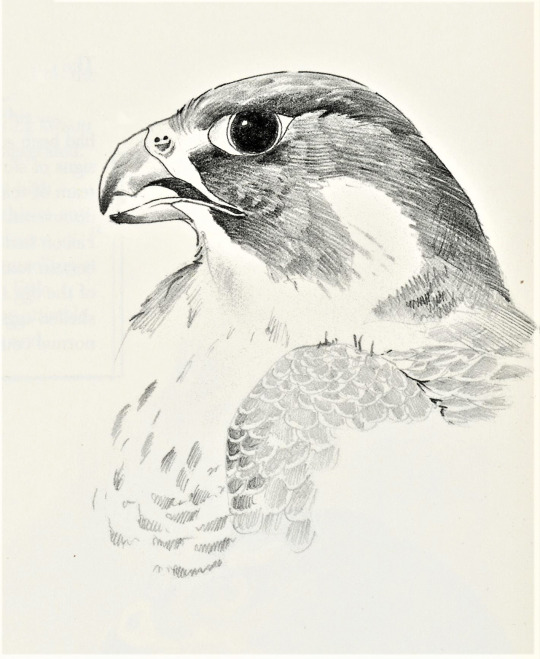


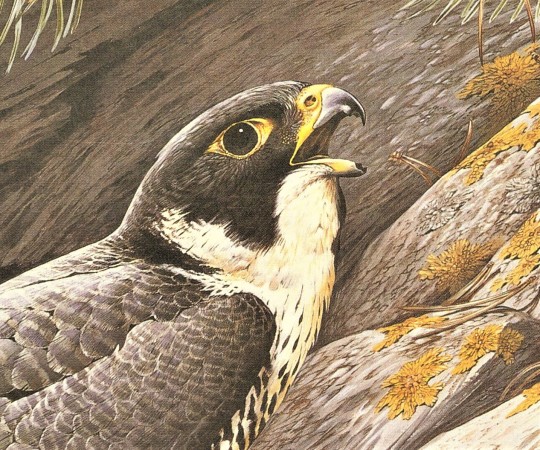
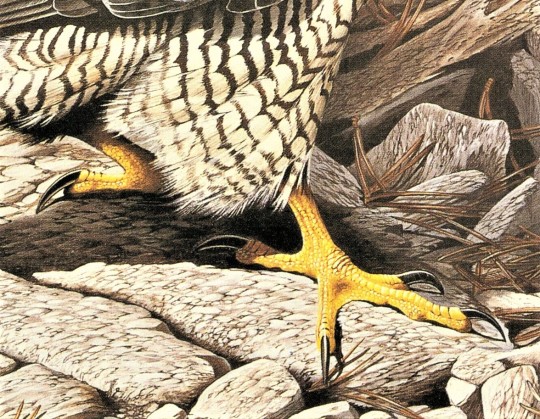

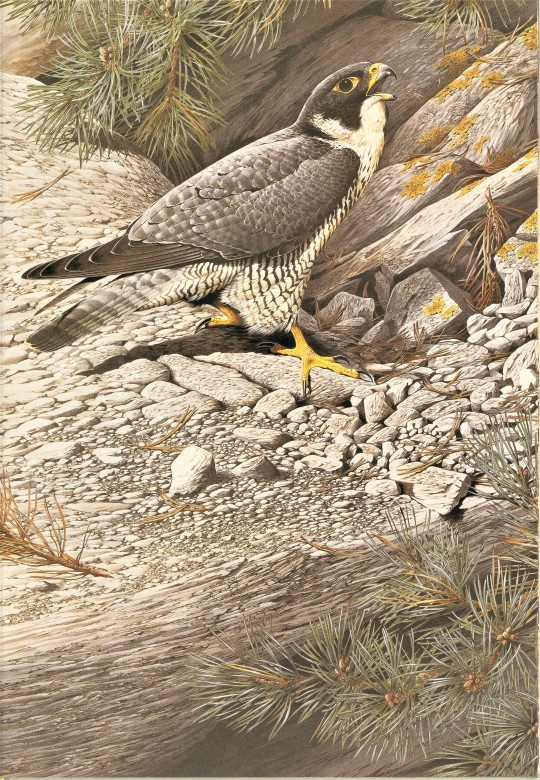
A Peregrine Feathursday
The Peregrine Falcon (Falco peregrinus) has made a remarkable comeback here in Wisconsin since its precipitous decline starting in the 1950s. While they are still endangered, they are gracing our skies in slowly increasing numbers every year, and they are no longer an uncommon neighbor. In Milwaukee we have several mating pairs and our tall city structures provide excellent nesting sites, including here at UWM on top of our Engineering and Math Science Building, which has its own falconcam to observe nesting behavior, but not much is happening this season yet. The city also offers an abundance of prey, so Peregrines are quite at home here.
The drawings and the painting presented here are from our folio volume Birds, The Paintings of Terance James Bond, by British bird artist Terance James Bond, published in Cambridge, England, by the Lutterworth Press in 1988. Of his painting of the Peregrine, Bond writes:
The bird shown in my painting is an adult male . . . calling from what could be a potential nesting site. As can be seen, various shades of grey are the predominant colours in the picture, but I felt this worked well. The high points of the painting are, of course the bird’s head and feet. Apart from being the most important part of a Falcon’s equipment, they also lend a note of relief to the painting by being bright yellow. The branches of the Scots pine introduce an extra colour and a different element in the form of foliage and help soften what is otherwise a very strong composition.
View more posts with paintings by Terance James Bond.
View more Feathursday posts.
#Feathursday#Peregrine Falcon#falcons#birds of prey#Terance James Bond#lutterworth press#bird paintings#bird drawings#bird artists#birds#birbs!
632 notes
·
View notes
Photo


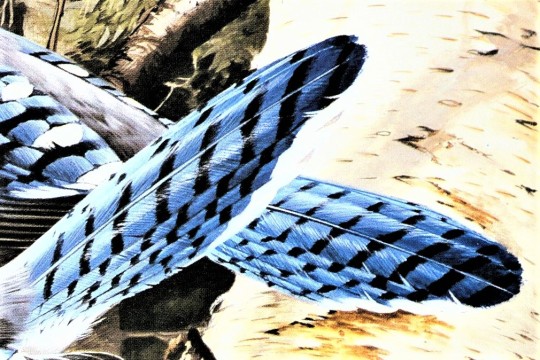
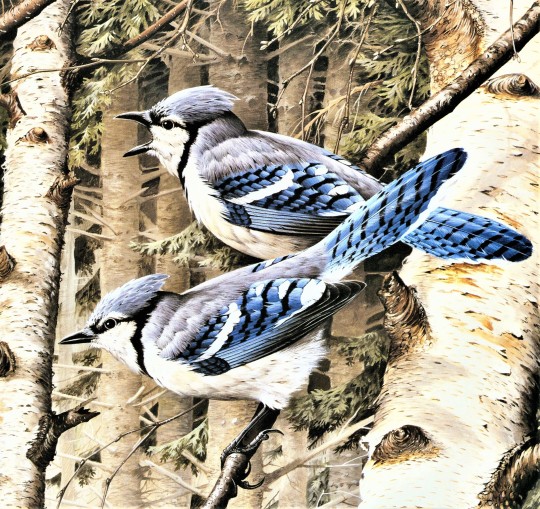
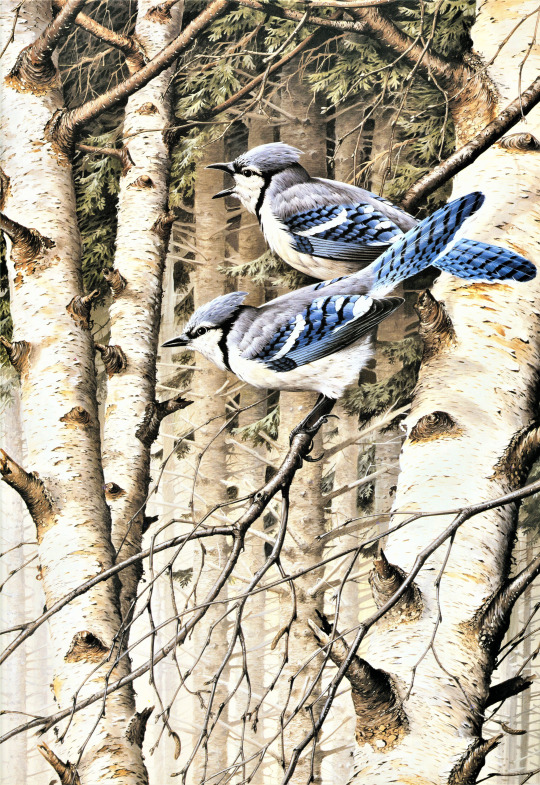
Feathursday Blue Jays!
Blue Jays (Cyanocitta cristata) are fairly common birds in Wisconsin woodlands and farmlands. Although not quite as plentiful in the urban and suburban areas around Milwaukee, their clear-blue presence brightens up our neighborhoods often enough. They are year-round residents, but we often don’t see or hear much from them in winter, except of course at the winter feeders. As the days grow longer and warmer, however, we are just beginning to hear their vociferous corvid calls more often.
The jays shown here are from our folio volume Birds, The Paintings of Terance James Bond, by British bird artist Terance James Bond, published in Cambridge, England, by the Lutterworth Press in 1988. In his rendering of these jays, Bond writes:
The bird’s plumage is very conspicuous. The tail and secondary wing feathers are of the brightest blue, and this is one of those pigments which gives the natural-history artist considerable trouble. The blue changes from one shade to another with every turn of the feathers. . . .
Rather than try to compete with the brilliant hues of the bird’s plumage, I have chosen to keep the background of the painting fairly understated and within a defined range of colour. The combination of birch and spruce trees also reflects the species’ more natural environment.
View more posts with paintings by Terance James Bond.
View more Feathursday posts.
#Feathursday#Blue Jay#Terance James Bond#Lutterworth Press#corvids#jays#bird paintings#bird artists#birds#birbs!
85 notes
·
View notes
Photo
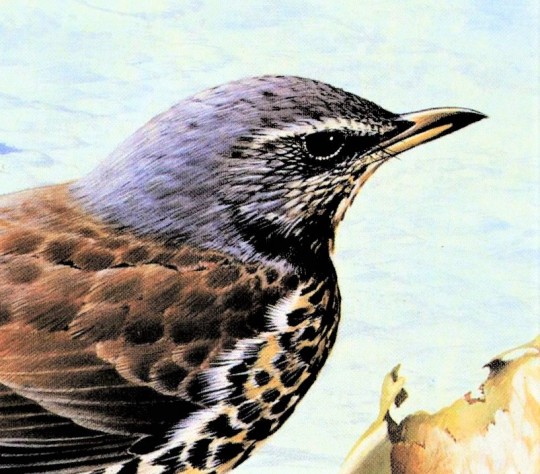
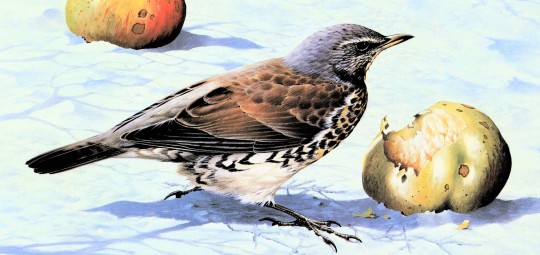
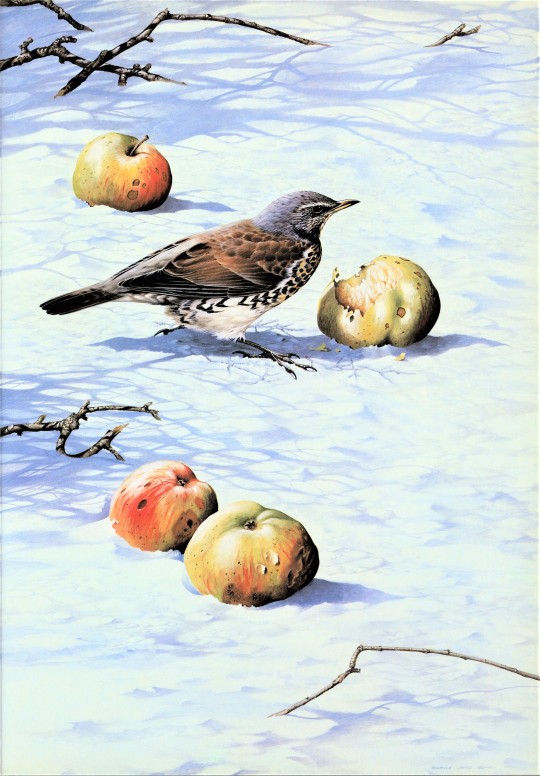
A Frigid Fieldfare Feathursday
After an unseasonably warm winter, Milwaukee has finally been hit by a bit of a cold snap this week (although still nowhere near what temperatures can be here in January). To celebrate a return of reasonably winter weather (although we know not everyone appreciates it), we begin the first #Feathursday of the year with a bird that just loves the winter climes, that lovely northern European thrush, the Fieldfare (Turdus pilaris). Once again we turn to our folio volume Birds, The Paintings of Terance James Bond, by British bird artist Terance James Bond, published in Cambridge, England, by the Lutterworth Press in 1988. Bond writes that Fieldfares arrive:
. . . in autumn from Scandinavia and will over-winter [in England] until returning during April to breed in their native land. . . . Apples are a favourite food for this bird and I have watched a single Fieldfare stand guard over an apple and despite being outnumbered several times, successfully defend its prize from Blackbirds and Mistle Thrushes. . . . Regardless, however, of this seemingly demonstrative and aggressive behaviour to other birds, the Fieldfare is rather shy. Unless forced by continuous cold weather, it would prefer to feed away from human habitation, and only on occasions is it found in the gardens of town houses.
A winter bird after our own hearts.
View more posts with paintings by Terance James Bond.
View more Feathursday posts.
#Feathursday#Fieldfare#Terance James Bond#Lutterworth Press#Birds The Paintings of Terance James Bond#thrushes#winter birds#winter#bird paintings#bird artists#birds#birbs!
77 notes
·
View notes
Photo

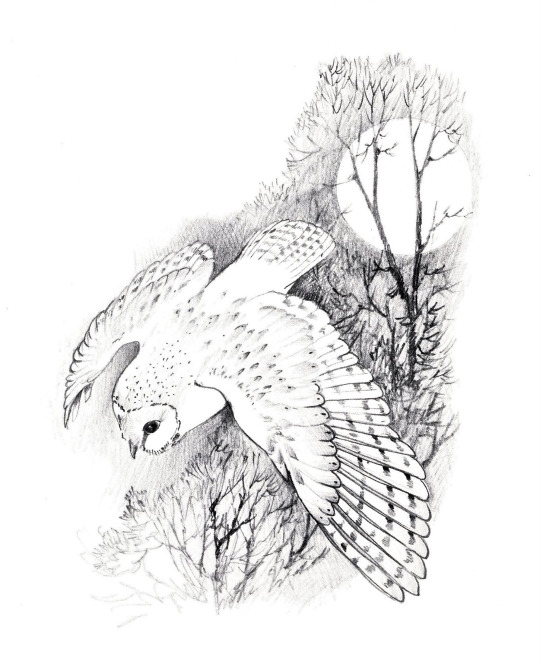
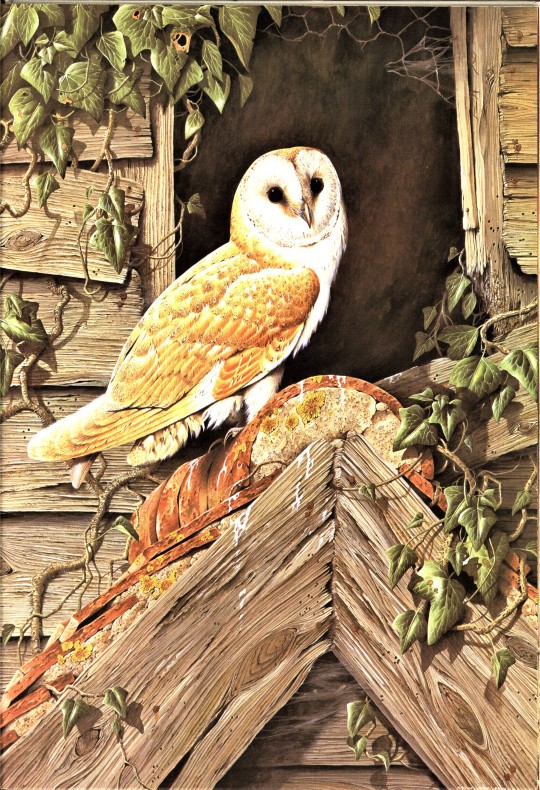
Monday Motivation Owl
The Barn Owl (Tyto alba) is perhaps the most widely distributed owl species on the planet. Yet, despite their ubiquity, the species is on decline in many parts of its range mainly due to habitat loss. The artist of these images, British bird painter Terance James Bond, writes in his 1988 book Birds, The Paintings of Terance James Bond, published in Cambridge, England, by the Lutterworth Press:
. . . the partly derelict old barn that I have included in my painting is a typical roosting place. Sadly the illustration . . . depicts a scene which is becoming increasingly rare. Barn Owls are on the decline, and so also are the old and accessible farm buildings in which the species prefers to nest. Hollow trees are just as suitable for nesting, but the loss of much woodland and many hedgerows during the last twenty years has affected the stability of this bird as a breeding species.
That was written 33 years ago, and prospects have not improved much over the past three decades. Still, when considering them as a global species, they are not considered threatened worldwide. While barn owls are prolific breeders and able to recover from short-term population decreases, they are not as common in some areas as they used to be. That is still true in Bond’s Britain, and here in Wisconsin and much of the Midwest barn owls are listed as endangered species.
Despite Bond’s lament, he also offers us this bucolic image:
I often watch a Barn Owl hunting over the long grass, drifting and turning through the trees of my meadow. Dusk is the usual time for these nocturnal predators to emerge from their daylight sleeping quarters. . . . Presumably the bird I watch with such pleasure is searching in my meadow for mice and voles, It looks for all the world like a large silent white moth drifting ghost-like over the tall grass.
View more posts with paintings by Terance James Bond.
View more motivated (and some unmotivated) owls.
#MondayMotivationOwl#Barn Owls#owls#Terance James Bond#Birds The Paintings of Terance James Bond#Lutterworth Press#bird paintings#bird artists#bird painters#loss of species#birds#birbs!
95 notes
·
View notes
Photo
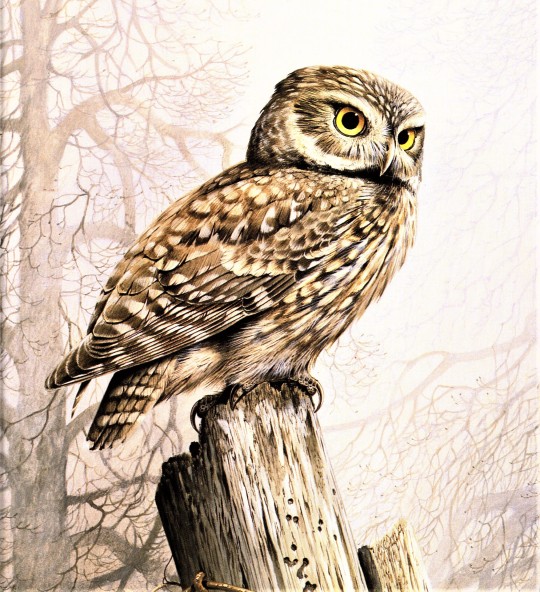
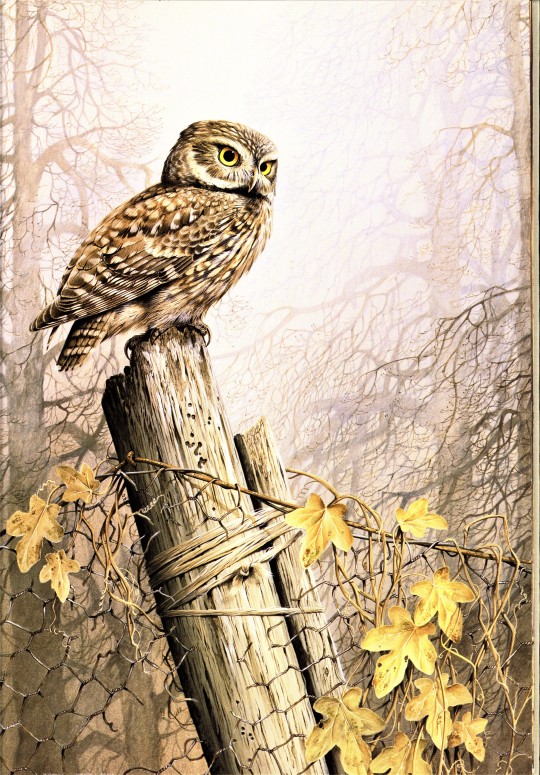

Monday Motivation Owl
For your general motivation this Monday, we present the Little Owl (Athene noctua) as painted and drawn by British bird artist Terance James Bond from his 1988 book Birds, The Paintings of Terance James Bond published in Cambridge, England, by the Lutterworth Press. This owl, which in ancient Greece and Rome was often associated with the goddess Athena, was an introduced species to England in the 19th century, and is now fairly widespread in southern and central England. Of this owl, Bond writes:
Despite the fact that the Little Owl is the smallest of the six species of owls resident in Britain, it is the most likely to be seen. When not actually hunting, the Little Owl will spend long periods just sitting, surveying the immediate surroundings from a suitable vantage point. . . .
Some years ago gamekeepers and landowners . . . claimed that game-bird chicks were being destroyed by predator owls. This resulted in intensive research by the British Trust for Ornithology to establish just what the owl did eat. Contrary to general belief if was proved that the diet of the Little Owl . . . consisted of insects . . . supplemented with ground-caught prey such as earthworks, beetles, voles, and other mammals.
View more motivated (and some unmotivated) owls.
#MondayMotivationOwl#owls#Little Owls#owl of Athena#Terance James Bond#Lutterworth Press#paintings#drawings#Birds The Paintings of Terance James Bond#birds#birbs!
105 notes
·
View notes
Photo
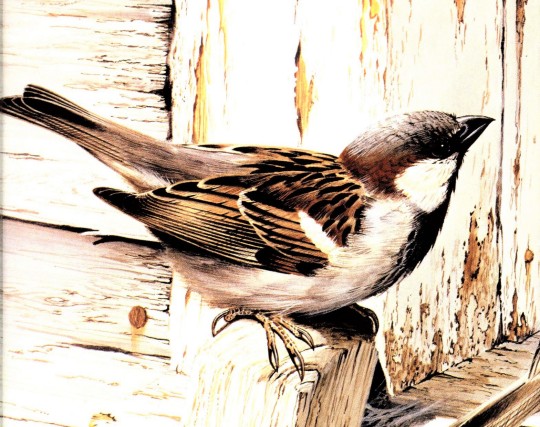
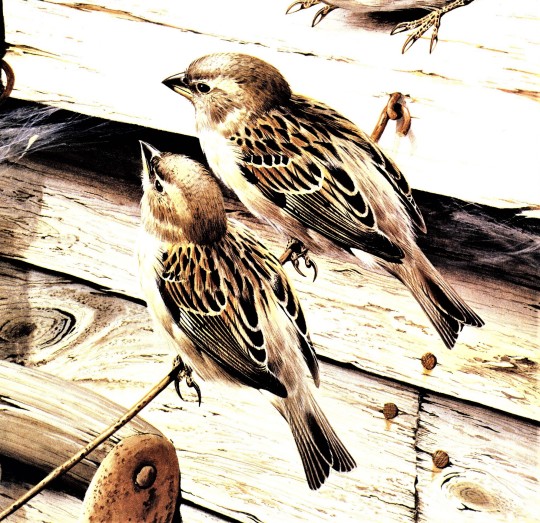
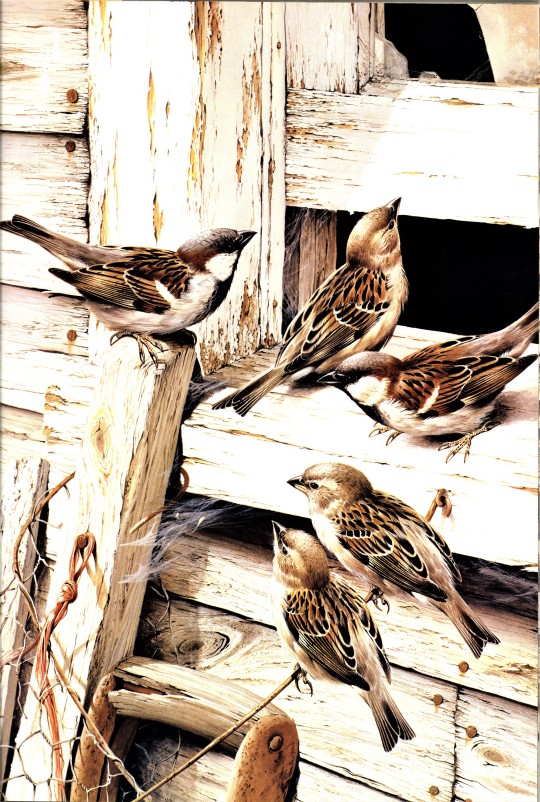

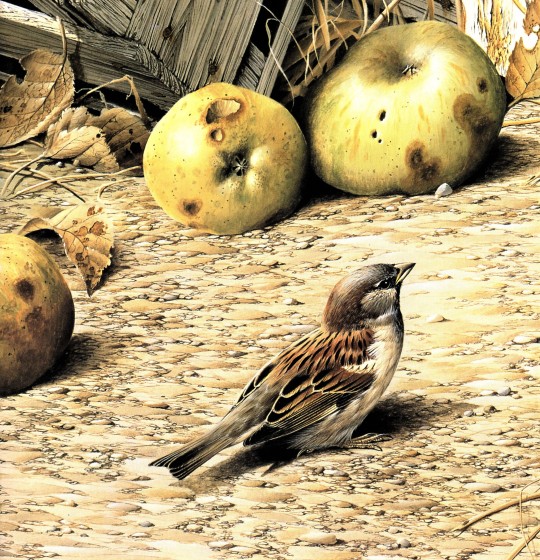
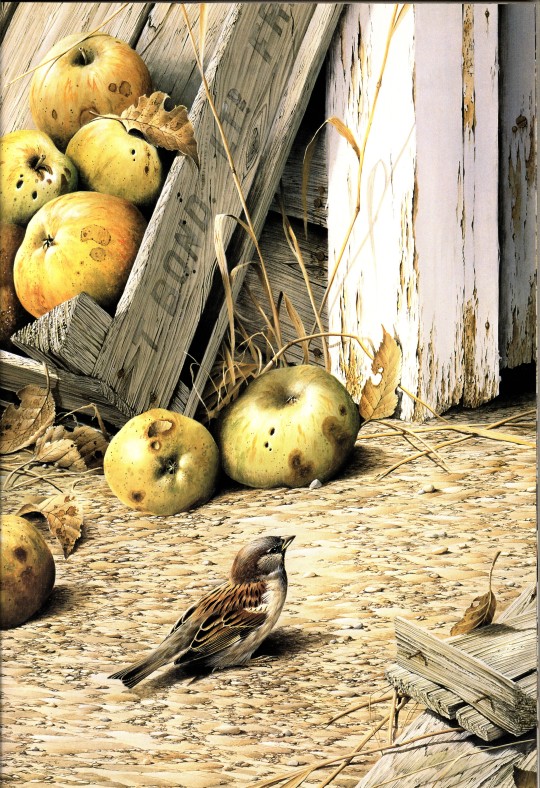
A House Sparrow Feathursday
Ah, the common House Sparrow (Passer domesticus)! So common, that we think of the species as the generic bird. Even their vocalizations are generic: cheep! or the fancier chirrup! Yet, these little, generic fellows are really quite charming and cheery. They are also very sociable. I once had a female House Sparrow as a pet when I was a child, and as my family were the only creatures it knew, it was an extremely sociable companion. I’ve had wonderful dogs and cats as family members, but this little bird is still my favorite. And even though House Sparrows are an introduced species in the Americas and have proliferated greatly, they are completely inoffensive, unlike some other introduced species.
To celebrate our bountiful little neighbors, we are showing these lovely paintings of House Sparrows by British bird artist Terance James Bond as reproduced in the 1988 book Birds, The Paintings of Terance James Bond published in Cambridge, England, by the Lutterworth Press. On painting House Sparrows, Bond writes:
All artists have their favourite colours and range of pigments. . . . My own particular preference is for browns and umbers, the shades that some people would refer to as autumnal. . . . Luckily my preferred colours occur on a bird which also happens to be a favourite subject of mine -- the common House Sparrow. Undoubtedly this would surprise many people. It would be normal to assume that given a free choice of subject, most artists would select something a little more dramatic, or a bird with more charisma and charm, but certainly not a sparrow.
Beauty, however, is in the eye of the beholder and for me the species Passer domesticus whilst generally overlooked or even dismissed as a bird of no interest, actually presents the artist with enormous possibilities.
View more Feathursday posts.
-- MAX, Head, Special Collections
#Feathursday#House Sparrows#Passer domesticus#Terance James Bond#paintings#Lutterworth Press#Birds The Paintings of Terance James Bond#birds#birbs!
79 notes
·
View notes
Photo
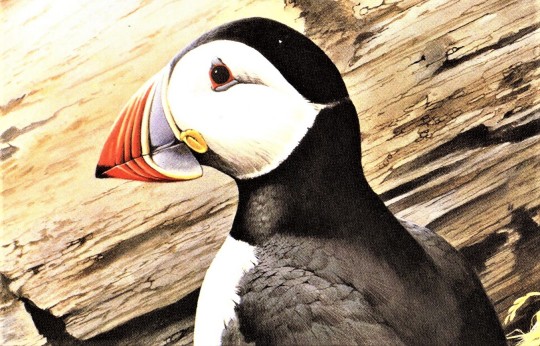

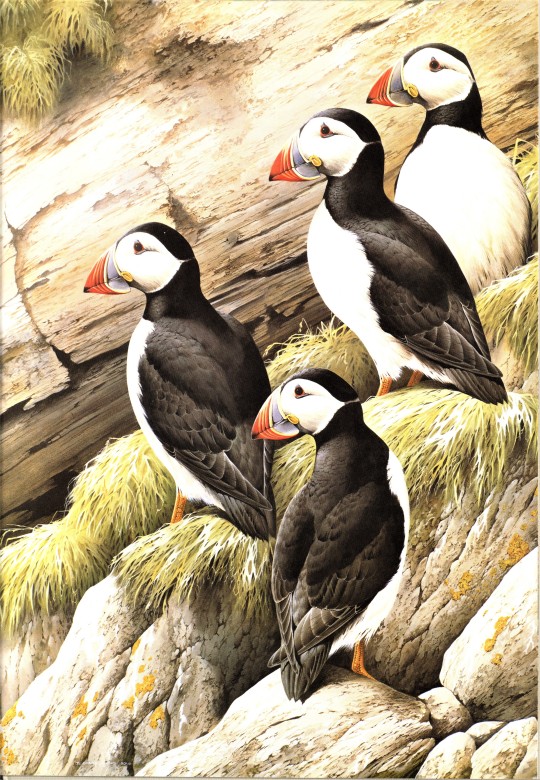

A Very Puffin Feathursday
This week we bring you . . . PUFFINS!! (Fratercula arctica), those absurdly beautiful little auks of the North Atlantic. Yes, they look like characters out of a Dickens novel, or perhaps creatures from Alice in Wonderland, or imaginary birds designed by a 9-year old, and indeed their colorfully silly appearance and waddling gait have earned them the nickname “clowns of the sea.” Nevertheless, Puffins are serious and noble animals, mighty deep-sea fishers, energetic burrow engineers, and serve patriotically as the official bird symbol for Newfoundland and Labrador.
Their striking appearance, of course, also makes them ideal subjects for bird painters and these images are from paintings by British bird artist Terance James Bond reproduced in his 1988 book Birds, The Paintings of Terance James Bond published in Cambridge, England, by the Lutterworth Press. Of Puffins and the making of the large painting, Bond writes:
To some people the physical appearance of the Puffin is most peculiar; large coloured bill, short dumpy legs and a generally awkward disposition. The bird’s popularity is, however, unquestioned and many regard the bird with great affection. . . .
My four Puffins are illustrated in a typical coastal cliff-top environment, with steeply sloping verges usually covered with a degree of grass and vegetation. In order to add more impact to the four birds I have resisted the temptation to show a horizon or background in the painting, preferring to use the combination of the Puffin’s dramatic plumage to create a strong composition.
View more posts with paintings by Terance James Bond.
View more Feathursday posts.
#Feathursday#Puffins#Atlantic Puffin#auks#bird paintings#bird painters#Terance James Bond#Birds The Paintings of Terance James Bond#Lutterworth Press#paintings#birds#birbs!#clowns of the sea
67 notes
·
View notes